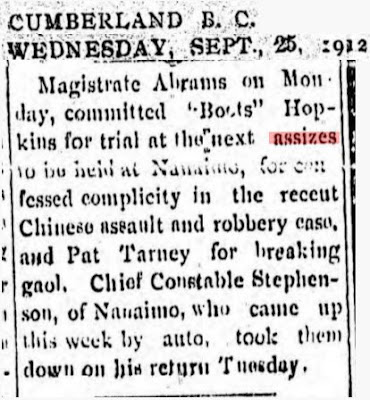Our fourteenth blog about the convicts interred at Boot Hill Cemetery (1913-1967, New Westminster, used by the old B.C. Penitentiary-which was razed in 1980) takes us back in history to the year 1912, on Vancouver Island, B.C. and a community of coal mining.
[Note: please see our links for previous blogs about the convicts at the end of the following account.]
Meet Convict #unknown - Phillip Hopkins
 |
| Photo by Kati (VSPI) - unknown gravemarker at Boot Hill Cemetery (April 2015) |
 |
| Courtesy Cumberland Museum Archives - 1913, Mine No. 4 (C164-010) |
Phillip Hopkins first entered into the news with a bang! Although information about him is difficult to find, I believe we have a much better picture of who he was and what happened to him, than what we first imagined.
 |
| Courtesy BC Historical Newspapers: The Islander, Cumberland BC (Sept.14, 1912) |
Where is this place, Cumberland BC? And what mines are they talking about?
 |
| Courtesy Google Maps - Nanaimo, Cumberland are both on Vancouver Island in B.C. |
 |
| Courtesy VPL - BC City Directories 1912, Henderson's, Cumberland BC |
 |
| Courtesy BC Archives - Accession No. 193501-001 (Robert Dunsmuir 1825-1889) |
 |
| Courtesy Cumberland Museum Archives - Chinatown & No.3 Mine (C040-001) |
 |
| Courtesy BC Historical Newspapers: The Islander, Cumberland BC (Sept.21, 1912) |
 |
| Courtesy BC Historical Newspapers: Cumberland News (Sept.25, 1912) |
 |
| Courtesy BC Historical Newspapers: The Islander, Cumberland BC (Sept.28, 1912) |
 |
| Courtesy Newspapers.com - Nanaimo Daily News (Oct.01, 1912) pg04 |
 |
| Courtesy Newspapers.com - Nanaimo Daily News (Oct.04, 1912) pg04 |
 |
| Courtesy BC Archives - Nanaimo Courthouse (Access.No.193501-001, Ref Code e-01891_141) |
 |
| Courtesy Newspapers.com - Vancouver Daily World (Mar.07, 1913) pg 31 |
We turn to Phillip Hopkins death certificate to learn more about the man and why he died.
 |
| Courtesy FamilySearch.org - Death Certificate (deceased March 06, 1913) |
Phillip Hopkins death is reported in both the 1913 "Minister of Justice Report" and the 1913 "Penitentiaries of Canada Report".
 |
| Courtesy UBC Open Collections - year ending Mar.31/1913 |
 |
| Courtesy UBC Open Collections - year ending Mar.31/1913 (Penitentiaries Report) |
The 1880 USA Census from Maryland located a family listing:
 |
| Courtesy Ancestry.ca - 1880 US Census, Baltimore, Maryland - family Hopkins |
Mother - Lizza Hopkins, laundress, born approximately in 1820.
Siblings - Fannie (1874), Bertha (1979) and Flora (1877).
It indicates that Phillip T Hopkins is in school at age 8 (1871-2).
The US Directories for 1880 confirms a Charles Hopkins, mariner, under the "colored persons" listing:
 |
| Courtesy Ancestry.ca - 1880 US City Directories - Charles Hopkins |
 |
| Courtesy Ancestry.ca - 1870 US Census, Baltimore, Maryland - Hopkins |
Was this Phillip's family? It may be, although they are from Maryland and not West Virginia. We took a look at the map to see how far apart these cities are.
 |
| Courtesy Google Maps - Baltimore, MD & Keystone. W.VA. |
 |
| Courtesy Google Maps - Baltimore, MD to Cumberland, B.C. |
His death certificate stated he had been in Canada for 11 years, so we can assume he arrived in the country in 1902. Did he travel across Canada from east to west working at different cities along the way? Perhaps. Why to Cumberland? The coal mine industry in B.C. was news around the world, and the news of Black Communities established on the Island since the 1850's may have driven his desire to travel west. We did not locate any further Canadian or American listings of Mr. Hopkins.
We end this blog with little understanding of whom Phillip Hopkins was and why he committed the crime he was convicted of. We will continue our search and update you if anything further is discovered.
Let's keep this man, and all the convicts who are buried at Boot Hill, in our thoughts. We do not fully know the reasons for any of their actions, but we can learn from them, and ensure our future is brighter than it was for those of long ago.
We invite you to read our other blogs (listed below) about the "Boot Hill" convicts, and join us in conversation on our Facebook page or email us via our Website. We'd love to hear your thoughts.
If you have any information to assist us with our research, we'd be ever so grateful for your help!
01) Meet Convict 1548 - Thompson
02) Meet Convict 2370 - Walsh
03) Meet Convict 2304 - Chinley
05) Meet Convicts 1628 - Herman Wilson + Unknown# - Joseph Smith
06) Meet Convict 1659 - Y. Yoshie
07) Meet Convict 1884 - Moses Paul
08) Meet Convict 2516 - Daniel Henrick Urick
09) Meet Convict 1948 - Unknown Gim
10) Meet Convict 2938 - Reginald John Colpitts
11) Meet Convict 5603 - Stephen Poole
12) Meet Convict 3130 - Harry Davis
13) Meet Convict 2312 - Albert Hill
14) Meet Convict Unknown# - Phillip Hopkins
15) Meet Convict #9720 - Norman Donald Bottineau
16) Meet Convict #2225 - Louie Num
17) Meet Convict #3237 - Harold Gordon McMaster
18) Meet Convict #4234 - Herbert Ross
19) Meet Convict #9693 - W. Black
20) Meet Convict #6651 - Gordon Wallace
21) Meet Convict #9511 - Henry Gordon Wichmann
22) Meet Convict #3348 - Frank Wilson
20) Meet Convict #6651 - Gordon Wallace
21) Meet Convict #9511 - Henry Gordon Wichmann
22) Meet Convict #3348 - Frank Wilson
Be aware of who is interred in the cemeteries you may visit and pay respect to them. No matter who they were in life, all people deserve kindness, even if they were convicted of horrendous crimes.
Kati
Sources: Cumberland Museum Archives; BC Archives; Ancestry.ca; FamilySearch.org; BC Historical Newspapers (UBC Open Collections); Wikipedia; Google Maps; Newspapers.com; BritishColonist.ca; Historica Canada; "Four Walls in the West" - by Jack David Scott; Canadian Encyclopedia; Vancouver History.














No comments:
Post a Comment